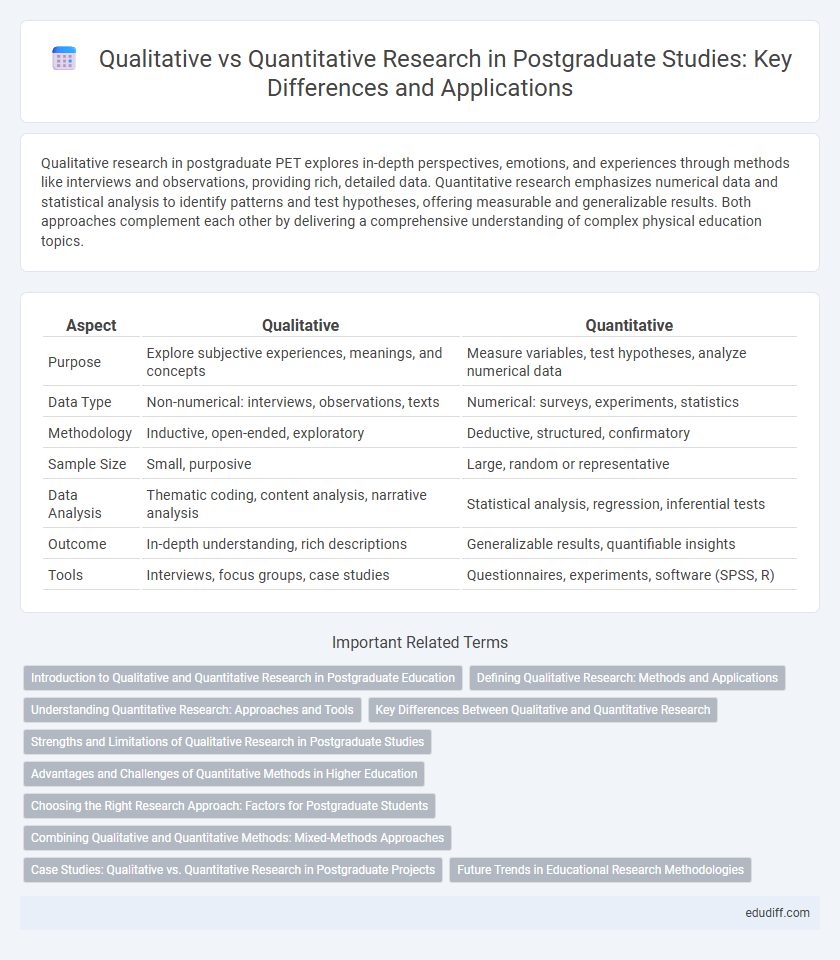Qualitative research in postgraduate PET explores in-depth perspectives, emotions, and experiences through methods like interviews and observations, providing rich, detailed data. Quantitative research emphasizes numerical data and statistical analysis to identify patterns and test hypotheses, offering measurable and generalizable results. Both approaches complement each other by delivering a comprehensive understanding of complex physical education topics.
Table of Comparison
| Aspect | Qualitative | Quantitative |
|---|---|---|
| Purpose | Explore subjective experiences, meanings, and concepts | Measure variables, test hypotheses, analyze numerical data |
| Data Type | Non-numerical: interviews, observations, texts | Numerical: surveys, experiments, statistics |
| Methodology | Inductive, open-ended, exploratory | Deductive, structured, confirmatory |
| Sample Size | Small, purposive | Large, random or representative |
| Data Analysis | Thematic coding, content analysis, narrative analysis | Statistical analysis, regression, inferential tests |
| Outcome | In-depth understanding, rich descriptions | Generalizable results, quantifiable insights |
| Tools | Interviews, focus groups, case studies | Questionnaires, experiments, software (SPSS, R) |
Introduction to Qualitative and Quantitative Research in Postgraduate Education
Qualitative research in postgraduate education explores complex phenomena through detailed, contextual analysis using methods like interviews and focus groups, emphasizing subjective experiences and meanings. Quantitative research relies on statistical techniques and numerical data to identify patterns and test hypotheses, employing surveys and experiments for generalizable results. Both approaches are essential for comprehensive postgraduate studies, offering complementary insights into educational processes and outcomes.
Defining Qualitative Research: Methods and Applications
Qualitative research involves exploring phenomena through non-numerical data such as interviews, focus groups, and observations to understand meanings, experiences, and social contexts. Common methods include thematic analysis, grounded theory, and narrative analysis, which provide in-depth insights into participant perspectives and complex behaviors. Applications of qualitative research span fields like education, healthcare, and social sciences, emphasizing subjective interpretation and rich, contextual data.
Understanding Quantitative Research: Approaches and Tools
Quantitative research in postgraduate studies employs statistical, mathematical, or computational techniques to gather and analyze numerical data, enabling precise measurement and hypothesis testing. Key approaches include surveys, experiments, and longitudinal studies, which rely on tools such as statistical software (SPSS, R, Stata) to generate valid and reliable results. This methodology prioritizes objectivity and generalizability, making it essential for producing scalable knowledge across various disciplines.
Key Differences Between Qualitative and Quantitative Research
Qualitative research explores subjective experiences and meanings through methods like interviews and thematic analysis, emphasizing depth over numerical measurement. Quantitative research relies on structured data collection and statistical analysis, focusing on quantifiable variables and generalizability of results. Key differences include data type, research purpose, and methodology, where qualitative investigates phenomena contextually and quantitatively tests hypotheses using large samples.
Strengths and Limitations of Qualitative Research in Postgraduate Studies
Qualitative research in postgraduate studies excels in providing in-depth insights into complex social phenomena, capturing participants' perspectives and contextual nuances that quantitative methods often overlook. Its strengths lie in flexibility, rich data collection through interviews and observations, and the ability to explore emerging themes without rigid hypotheses. However, limitations include challenges in generalizability due to smaller sample sizes, potential researcher bias, and time-intensive data analysis processes.
Advantages and Challenges of Quantitative Methods in Higher Education
Quantitative methods in higher education offer the advantage of providing measurable and statistically significant data, enabling researchers to generalize findings across large populations with higher reliability. Challenges include the risk of oversimplification of complex social phenomena and the potential for missing contextual nuances crucial for understanding student behaviors and educational outcomes. Effective use of quantitative methods requires rigorous design of experiments and surveys to ensure validity, accuracy, and relevance in postgraduate research contexts.
Choosing the Right Research Approach: Factors for Postgraduate Students
Postgraduate students should consider research objectives, data type, and available resources when choosing between qualitative and quantitative approaches. Qualitative research excels in exploring complex phenomena through interviews, focus groups, and thematic analysis, while quantitative research emphasizes statistical validation using surveys and experiments. Aligning the research methodology with academic goals enhances data reliability and the overall impact of postgraduate studies.
Combining Qualitative and Quantitative Methods: Mixed-Methods Approaches
Mixed-methods approaches in postgraduate research integrate qualitative insights and quantitative data to enhance the depth and breadth of analysis. Employing both methods allows for the validation of findings through triangulation, increasing reliability and comprehensive understanding of complex phenomena. This combination supports methodological rigor by addressing research questions from multiple perspectives, improving the robustness of conclusions in fields like social sciences and health studies.
Case Studies: Qualitative vs. Quantitative Research in Postgraduate Projects
Case studies in postgraduate projects often utilize qualitative methods to explore complex phenomena through detailed contextual analysis, emphasizing themes, patterns, and participant experiences. Quantitative case studies, however, rely on numerical data and statistical techniques to test hypotheses and measure outcomes within specific contexts. Selecting between qualitative and quantitative case studies depends on research goals, with qualitative approaches favoring depth and interpretation, while quantitative focuses on generalizability and objectivity.
Future Trends in Educational Research Methodologies
Emerging trends in educational research methodologies emphasize integrating qualitative and quantitative approaches through mixed methods to capture complex learning environments more holistically. Advancements in data analytics and artificial intelligence are enabling more sophisticated analysis of qualitative data, enhancing the depth and scalability of insights. Increasing emphasis on participatory and iterative research designs reflects a shift towards contextualized and adaptive inquiry to address evolving educational challenges.
Qualitative vs Quantitative Infographic

 edudiff.com
edudiff.com